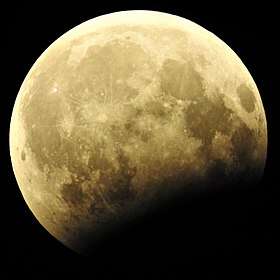Danjon scale
.jpg)
The Danjon Scale is a five-point scale useful for measuring the appearance and luminosity of the Moon during a lunar eclipse. It was proposed by André-Louis Danjon in 1921, when postulating that the brightness of a lunar eclipse was related to the solar cycle.[1] An eclipse's rating on the scale is traditionally denoted by the letter L.
The scale
The scale is defined as follows:
| L value | Description |
|---|---|
| 0 | Very dark eclipse. Moon almost invisible, especially at greatest eclipse. |
| 1 | Dark Eclipse, grey or brownish in coloration. Details distinguishable only with difficulty. |
| 2 | Deep red or rust-colored eclipse. Very dark central shadow, while outer edge of umbra is relatively bright. |
| 3 | Brick-red eclipse. Umbral shadow usually has a bright or yellow rim. |
| 4 | Very bright copper-red or orange eclipse. Umbral shadow has a bluish, very bright rim. |
Determining the value of L
Determination of the value of L for an eclipse is best done near mid-totality with the naked eye. The scale is subjective, and different observers may determine different values. In addition, different parts of the Moon may have different L values, depending on their distance from the center of the Earth's umbra.
Factors affecting the value of L
Many factors can affect the appearance of the Moon during a lunar eclipse. The Moon's path through the Earth's umbra is important, but so too are the current conditions of the Earth's atmosphere. While the Earth's shadow blocks any direct light from striking the Moon during a lunar eclipse, some light is refracted through the Earth's atmosphere giving the Moon a red hue.
The amount of light refracted affects the brightness of the moon at mid-eclipse, and this depends on several factors. Volcanic eruptions are one of the most significant - eruptions which spew significant amounts of volcanic ash into the air are generally followed by several years of dark, deep red eclipses. The effect of the eruption of Mount Pinatubo on subsequent lunar eclipses was very noticeable, with the eclipse of 9 December 1992 rated 0 on the Danjon Scale by many observers.
It is also thought that the solar cycle has some effect on the darkness of lunar eclipses--indeed Danjon established the scale for this reason.
= New Danjon Number: Danjon-Falcon Factors for RGB digital Imagen
New results about the number of Danjon in digital photography of eclipses has been published by Falcon and Ortega (2018) http://www.sedoptica.es/Menu_Volumenes/Pdfs/OPA_51_3_50025.pdf
The qualitative scale used to determine the magnitude and chromaticity, known as Danjon's number, is not sufficient to unambiguously characterize these magnitudes. A methodology is sought to determine a well-defined scalar, which links the Danjon number to the RGB digital color of the photographs, called the Danjon-Falcon Factor (FD);
FD≡ 0.0028*√(R^2+G^2)
where R and G are de value of color digital index (0,255).
References
- ↑ Danjon, A. "Relation Entre l'Eclairement de la Lune Eclipsee et l'Activite Solaire". L'Astronomie. 35: 261–65. Bibcode:1921LAstr..35..261D.
Falcon, N Ortega, A. (2018)Danjon Number and RGB-colors in Total Lunar Eclipse: 2000-2017 Optica pura y aplicada 51 (3) Pages: 50025:1-14 DOI: 7149/OPA.51.3.50025 http://www.sedoptica.es/Menu_Volumenes/Pdfs/OPA_51_3_50025.pdf

